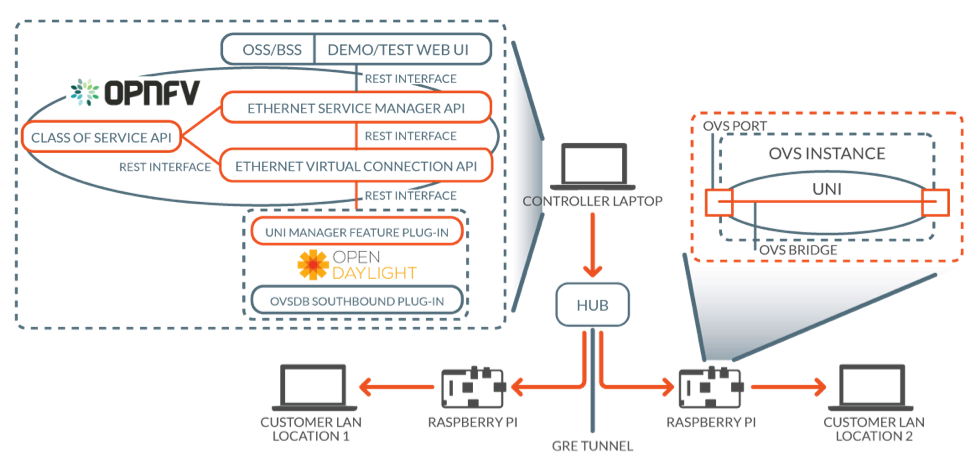Networking
Making Network Virtualization and Carrier Ethernet Easier

A CableLabs Demonstration of SDN with OpenSource Software
Seeing is believing, especially with all of the hype and limitless possibilities that new technologies promise. It is refreshing to quickly build a prototype for a real customer use case without all of the smoke and mirrors. Through an open and collaborative effort, CableLabs and BSS/OSS solutions provider Intraway developed a proof-of-concept and demonstration using open source software. This demonstration manages virtualized customer premise equipment (vCPE) and is compliant with Metro Ethernet Forum (MEF) defined Carrier Ethernet services. Details on the demonstration and how you run and build upon this work will be shared later in this post.
Software-Defined Networks and Network Function Virtualization, commonly known as SDN and NFV, are terms that are present in every telecommunications engineer’s mind today. It is hard to look at a technical newsletter or site without seeing at least one article with those acronyms.
Most Communications Service Provider (CSP) executives know what these letters mean in essence, and that they represent a shift in the networking paradigm. The real question is not how trendy this technological approach is, but rather if it is still just hype or if there are genuine business opportunities for service providers. In this article, we intend to answer that question. And, here’s a spoiler: this technology is closer than you think.
But, why would any CSP want to adopt this technology so early?
CableLabs sees three key benefits for leveraging SDN and NFV technologies:
- Reduce time to market
SDN and NFV allow for more flexible and agile deployment of networks and network services - Reduce operational expense
SDN and NFV enable greater automation of network configuration by exposing network functions through application programming interfaces (APIs) - Facilitate rapid innovation
Networking functions implemented in software can be developed, verified, and deployed - or rejected - far faster than hardware development cycles allow.
For instance, what happens in a non-virtualized environment when a customer requests a bandwidth upgrade for all its branches? Normally, it would take weeks to manually gather the network configuration. Then there are the planning, designing and delivery stages, which can take months. And what if that upgrade request was made to handle a high-demand period? Too often, by the time the service operator is ready to deliver, the high demand is over. But SDN/NFV, along with an orchestration layer, delivers new services and change requests in a matter of days or even hours. With SDN and NFV adoption, rapid innovation is the new network paradigm. It opens so many doors to new sources of revenue that we are just starting to imagine the possibilities. This technology represents such a shift that while not yet fully realized, its promise is already changing the business playbook for MSOs.
The Enabling Technology
SDN is commonly characterized as the separation of the networking equipment’s control capability from the data manipulation and forwarding processes. By separating the control of networked equipment from the hardware, SDN provides an opportunity to programmatically configure the network. By exposing control of networked elements through a software programming interface, configuration and control of the network can be automated through software scripts or applications.
Software controlling operation of networking equipment can be modified and tested easily, and deployed much faster than the design-build-test cycle of the hardware. Thus, SDN provides the opportunity to greatly streamline not only the initial deployment of services on the network, but also later modification and maintenance.
NFV is the modularization of functionality in networking equipment so that it can be separated from the network hardware and potentially executed outside the equipment in a sequence determined by the network engineer. NFV creates the opportunity to both simplify network hardware and introduce flexibility in the network architecture. Examples include network functions such as routing, load balancing, packet inspection, and firewall. When implemented in software as independent virtual network functions (VNF), data handling processes such as these can be invoked and chained together as needed.
CableLabs established early leadership in virtualization technology for deploying business services by exploring the use of open source SDN controller platforms to configure networking equipment for delivering business/commercial services. Open source refers to the software development by a community of talented developers that are not necessarily all working for the same company. Open source development allows for progress to be made at a pace that is not necessarily tied to a particular organization’s product schedule or hardware specifics.
The Demonstration
But if SDN and NFV are to be more than a collection of proprietary, semi-closed ecologies, there needs to be a working reference model that the greater communications community can look to for ideas, guidance, and benchmarks.
CableLabs initiated a proof-of-concept project called the Virtualized Business CPE demonstration. The goal of the project is to demonstrate a properly implemented, open-source based SDN solution to support existing services. Intraway volunteered to join CableLabs (with consultant Inocybe Technologies) in this open-source effort.
Service activation and live modification of business services typically have the longest lead time and often require the most manual intervention. These use cases were selected for the initial demonstration. A point-to-point Ethernet circuit between two User Network Interfaces (UNIs) was chosen as the service. To demonstrate that SDN functions need not be proprietary, we used OpenDaylight as the control plane, OVSDB for the communications interface, and Open vSwitch to do the actual switching in the CPE devices.
For the hardware, we chose to use two Raspberry Pi devices to host the UNIs, an eight port Ethernet switch (to act as the network) and a laptop running Ubuntu Linux acting as the controller. Connected to each of the Raspberry Pi UNIs were laptops acting as the clients or end-devices. (The operating system of the two ‘client’ laptops is not important.)

Finally, a web interface on the controller laptop is used to configure and initiate the creation of the services.
This demonstration shows the creation of an Ethernet Private Line (EPL) between the two Raspberry Pi devices at a set bandwidth rate. After connectivity and traffic are established, we instruct the network to modify the existing rate through the controller software, which then issues instructions to the Raspberry Pi devices. The bandwidth of the EPL is immediately changed without having to tear down and rebuild the circuit!
Conclusion / Next Steps
With the success of the proof-of-concept, the source code is now publicly available in the open source project’s code repositories. CableLabs members and the vendor community can operationalize these concepts for many business services.
OpenDaylight
[highlighter line=0]
git clone https://git.opendaylight.org/gerrit/unimgr
OPNFV
git clone https://gerrit.opnfv.org/gerrit/lsoapi
This open collaboration with participation and feedback from CableLabs members, along with the active participation of vendors such as Intraway and Inocbye in open source projects, is one way that CableLabs helps ease the path forward with the adoption of new technology.
The Virtualized Business CPE demo, developed by CableLabs with participation from Inocybe Technologies and Intraway, will be featured at CableLabs 2016 Winter Conference in Orlando, Florida. If you are attending the conference, stop by to catch a glimpse of the future!
Randy Levensalor is a Lead Architect in the Wired Networks group at CableLabs.

